Kayaking the Rossport Islands
Off Ontario's Superior coast, a lighthouse is an irresistible destination.
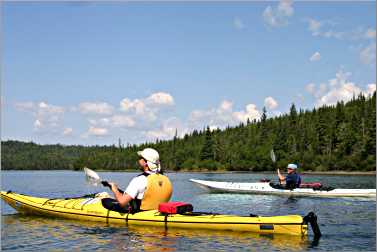
© Beth Gauper
At the top of Lake Superior, there's a dramatic coast lined with rugged cliffs, cobblestone beaches and islands.
It's the home of Parks Canada's Lake Superior National Marine Conservation Area, created to protect the waters between the Sibley Peninsula, east of Thunder Bay, and the Slate Islands, off Terrace Bay.
These waters are thick with islands, much like the Apostles in Wisconsin, except the islands are closer together. That makes them ideal for kayaking.
The Slate archipelago, where caribou live, attracts serious kayakers. But the Rossport Islands are perfect for any paddler.
Two hours east of Thunder Bay, novices can explore the small islands around Rossport's harbor, shielded from the big lake by a quartet of large outer islands.
More adventurous paddlers can make their way out to a third tier of islands, smaller but shielded from winds that blow from the north.
On one of those islands, there's a 1911 lighthouse, one of the last Great Lakes lighthouses still tended by a keeper when it was automated in 1991. The retired keeper would spend his summers tending its grounds, and if he was in a good mood, he'd show visitors around.
One July, I paddled out to Battle Island with my husband and guide Aaron Nicholson of Superior Outfitters in Rossport.
Islands rose in tiers around the harbor, and we headed for the gaps between them.
We pulled into Wilson Island so my husband could adjust his foot rest, and stepped out onto a magnificent cobblestone beach.
There were smooth, round stones in an array of colors and stripes, a paradise for children and rockhounds, and I realized that this is what every beach on Lake Superior must have looked like before tourists began carting off the prettiest stones for landscaping.
A bald eagle burst from the trees as we paddled away. As we approached Salter Island, the slight chop of the waves calmed into near glass.
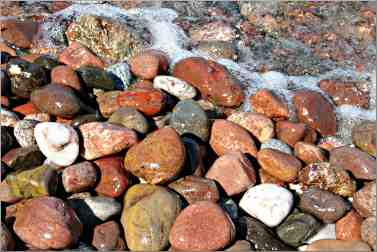
© Beth Gauper
Lulled by the fair skies and easy paddling, I was surprised when Nicholson pointed out a rock shoal nearing my bow, in the middle of the channel. The islands provide haven, he said, but not necessarily safe passage.
"It's taken down some big ships," he said. "Have you heard about the Gunilda?"
Story of the Gunilda
The Gunilda was an American luxury yacht that tried to sail into Rossport in 1911. Its captain asked its owner, a New York oil baron, to let him hire a local pilot to guide them around the shoals, but the owner balked at the fee.
The yacht grounded, and a tug was called to pull it off. The tug captain recommended that two boats be used to lift the 166-foot boat off the rock, but the owner again refused to pay the extra cost.
As soon as the Gunilda was pulled free, it sank in 265 feet of water, with all its mahogany, crystal, china and fine wine.
Many people have tried to salvage it, Nicholson said, but so far they've succeeded only in bringing up part of the mast, now the flagpole of the Rossport Inn. Jacques Cousteau called it the most beautiful wreck in the world.
The well-preserved wreck, its gold-leaf scrollwork clearly visible, is a favorite site for technical divers, who call it "the G spot."
"It's fun to hear the stories," Nicholson said. "There are still people around here with a treasure-hunt mentality."
We pulled into Battle Island, had lunch on the curving harbor, then walked down a spruce-lined path to the immaculate keeper's house and tower. There was no sign of keeper Bert Saasto, and Nicholson warned us that he doesn't always socialize with visitors.
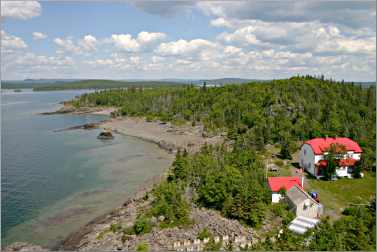
© Beth Gauper
'The genuine article'
But as we were hanging around on the lichen-covered point, admiring clumps of deep-purple harebells nodding in the breeze, Saasto walked up. We introduced ourselves, and he started talking about life on the rocks.
"GPS put lighthouses out of business," he said with a wry smile. "I was the last keeper. I'm the genuine article."
Every September, Saasto had a helicopter pick him up and take him to Thunder Bay for the winter.
But when he was working, he stayed through November, and he was on the island during a 1977 storm in which 30- to 40-foot waves lifted fuel tanks off their concrete cradles and pounding surf blew out the windows of the tower, 70 feet above the lake.
"The most frightening thing is the sound," he said. "It's like a freight train going by; it's deafening. That's what puts the fear of God into you, the sound."
It wasn't the last storm he weathered during his 14 years as keeper.
"It's what they call a sublime experience — you're fascinated and afraid at the same time," he said.
We'd just visited a half-dozen other Superior lighthouses, so we traded stories for a while, and then he got his keys and opened the gates to the tower, which we admired from the concrete helipad. Then he said, "Well, do you want to go up?"
It was the first time Nicholson ever had been invited to climb the tower. Battle Island Light never had a Fresnel lens, and when we reached the top, we were surprised to see a bulb the size of a book light, a 100-watt halogen bulb with a revolving parabolic reflector — low-tech, but still effective for 10 miles.
From the catwalk, we had a panoramic view of the islands, and we thought we could see Isle Royale on the horizon, but Saasto said it was a mirage.
"You can't see below the horizon," he said. "You can only see 30 miles, and it's 80 miles south until you hit Yankee Doodle land."
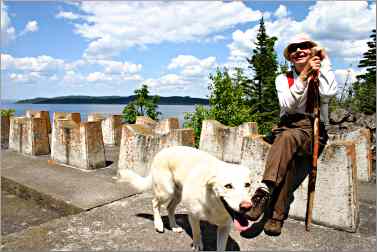
© Beth Gauper
By then, Saasto was getting warmed up. The lighthouse was removed on nearby Talbot Island, which was called the Island of Doom, he said, because three of its keepers died there. Of course, a keeper drowned on Battle Island, too.
"It's not for everyone," he said. "Some people try it and go stir crazy, but I always have a lot to keep me busy."
When we headed back, the waters still were calm. But when we emerged into the Wilson Channel, the winds were coming from the north and also the northwest, the only two directions from which islands don't protect kayakers.
The waves were breaking every which way, and Nicholson called them "confused seas."
"It's hard to read the water when the wind is breaking on the islands," he said.
It was hard work paddling, and several times waves filled my spray skirt with water. But our 17½-foot sea kayaks didn't waver.
"I've had waves hit me in the face and wash over my head, and the boat is still very stable," Nicholson said.
It wasn't the free ride we got paddling out, but it was still a treat. When we got back, he gave us a map of the islands and campsites, and said we needed to come back for an overnight stay. It's already on our list.
Trip Tips: Kayaking the Rossport Islands in Ontario
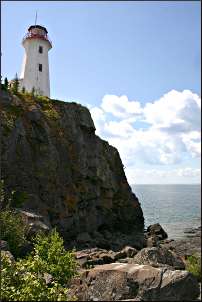
© Beth Gauper
Getting there: Rossport is about three hours from the U.S. border at Grand Portage and a two-hour drive from Thunder Bay.
Border details: U.S. residents need passports.
Kayaking: SAND Adventure Expeditions offers day tours, multi-day expeditions, rentals and instruction.
Accommodations: Guests should know that trains go through the village, usually two or three at night.
In Rossport, the Willows Inn B&B has a view of the harbor from its pretty deck and four attractive rooms. The Quarry Room has two single beds; the Wilson has a sitting area with a great view.
The Serendipity Gardens Guest House doesn't have a view, but its four suites, each under hand-crafted Romanesque-style arches, are attractive and have kitchenettes.
Camping: Nearby Rainbow Falls Provincial Park has two campgrounds with showers, a beach on Whitesand Lake and, of course, a beautiful waterfall. The Casque Isles Trail runs through the park, and canoes and bicycles can be rented. 807-825-3406.
Dining: Serendipity Gardens Cafe is very pleasant place to eat and has a view of the bay.
Nearby attractions: For more, see Circling Lake Superior.
Rossport is a good stop on the Circle Tour. For more, see Planning a Circle Tour of Lake Superior.